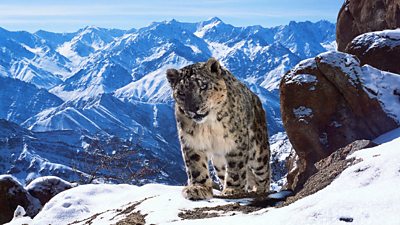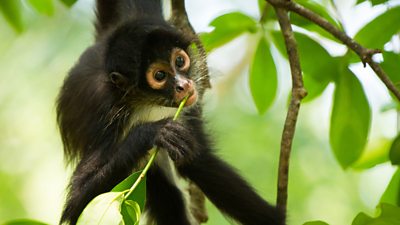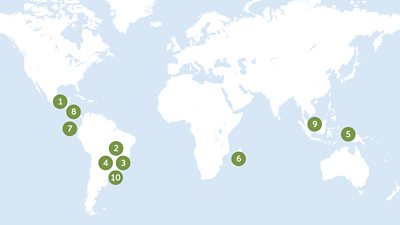Jungles
Jungles are the richest places on earth. A magical world of surprise, drama and unforgettable wild characters. From the Jungles of Brazil, home to caiman hunting jaguars and strange jungle dolphins that swim in the tree tops, to Costa Rica where ninja frogs fight huge wasps, we watch as the animals face life in the most competitive place on earth. We follow alongside the beautiful indri as she bounces through the forest in Madagascar and stay out late at night to witness glow-in-the-dark creatures never before filmed! There are even mini ‘dragon lizards’ with a special trick to deal with life in the jungle!

Jungles are the richest places on earth. A magical world of surprise, drama and unforgettable wild characters. From the Jungles of Brazil, home to caiman hunting jaguars and strange jungle dolphins that swim in the tree tops, to Costa Rica where ninja frogs fight huge wasps, we watch as the animals face life in the most competitive place on earth. We follow alongside the beautiful indri as she bounces through the forest in Madagascar and stay out late at night to witness glow-in-the-dark creatures never before filmed! There are even mini ‘dragon lizards’ with a special trick to deal with life in the jungle!
Big facts
- More new species are found in the worlds jungles than anywhere else on land.
- Jungles cover less than six percent of land, but are home to over half the plants and animals on earth.
- Jungles are richest and most crowded place on earth, home to a billion individuals trying to survive.
- Only two percent of the sun’s rays reach the jungles forest floor.
- Each day the world’s jungles make five million tonnes of water, one fifth of the fresh water on the planet is created here.
Key characters and stories

Key characters and stories
Bioluminescent Fungi; Coconut Forest, Brazil
- New low light cameras helped the team to film the amazing glowing fungi of Brazil for the first time.
Birds Of Paradise; West Papua, Indonesia
- For the first time, the display of the Wilson’s bird of paradise is revealed from its true perspective from above - as the female would see it.

Jaguars; Amazon River, Brazil
The team spent six weeks on the Amazon River to capture the most detailed hunt sequences of jaguars ever filmed.
- For their size, jaguars have the most powerful bite of any cat and are powerful enough to kill caiman, a relative of the crocodile, that can reach up to 10 feet in length.

Spider Monkeys; Flores, Guatemala
- 90 percent of animals in jungles spend their whole lives up in trees where agility is key to success.
- Spider monkeys are shaped for life in tree tops ,with long limbs and a prehensile tail to grip like hands – the young have to learn to walk 50 feet up in a tree.
Humming Birds; Tandayapa Valley, Ecuador
- 100 types of Hummingbirds live here alone.
- Swordbills are the only bird with a beak longer than their body, allowing them to feed from flowers that are too long for many other birds. But they are also the only bird that can’t reach their own feathers with their beak.
Indri; Andasibe, Madagascar
- Stabilised camera systems helped in capturing footage of the graceful indri as it leaps through the trees, sometimes as far as 10 metres in a single leap.
Glass Frogs; Siquirres, Costa Rica
- Male glass frogs are only the size of a finger nail, but they are one of the toughest animals on earth. The male guards his eggs for two weeks on the underside of leaves, and when attacked by wasps he puts himself in danger and karate kicks the wasps away.
Filming locations

Snow Leopards; Himalayas, Ladakh, India
- The Planet Earth II sequence is the first time that four snow leopards have ever been filmed together. With as few as 3,500 snow leopards remaining in the wild, they are incredibly elusive and hard to film.
- The camera traps used were reengineered to give better operating quality and to survive in the toughest field conditions; the highest camera trap was operating close to 5000 metres.

1. Spider monkeys - Flores, Guatemala
2. Araguaia river dolphins - Cantão Park, Brazil
3. Jaguars - Brazil
4. Bioluminescent fungi - Coconut forest, Brazil
5. Birds of paradise - West Papua, Indonesia
6. Indri - Andasibe, Madagascar
7. Humming birds - Tandayapa Valley, Ecuador
8. Glass frogs - Siquirres, Costa Rica
9. Draco - Kuching, Malaysia
10. Railroad worms - Sorocaba, Brazil
Stories from location
The jungle is the most amazing place in the entire planet! The variety of insects, plants and animals is breathtaking but for many of these species very little is known about them and even less have been filmed successfully.
The jungle has the perfect conditions for life, it is wet and at the top of the trees there is sunshine all year round. But at ground level it is dark and wet. Hard conditions to work in and even harder to film. You can’t use most of our equipment if it’s raining, and rain can last for days on end!
The rainstorms can be more than just an inconvenience. On one shoot, in the Brazilian flooded forest, we were travelling down river looking for a new species of river dolphin and suddenly out of nowhere this incredibly hard rainstorm came. It was hail, which the local people had never seen before and it completely stopped us in our tracks. It immediately broke the electric motor on the boat, which meant we couldn’t go anywhere and we were in danger of being pushed downstream without any way to stop ourselves. We pushed ourselves over to a sandy riverbank and the trees just started falling around us. We were lucky that no trees hit us and the storm calmed down and we survived, but there was about an hour of being stuck in the storm, not knowing how to get back to camp or where the rest of our team had gone. We were in the middle of nowhere, there was no medical care. It was scary!
The other challenge of filming in the jungle is that the undergrowth is really dense, which means it can be hard to see and follow the animals for long enough to film them. When filming jaguars in Brazil the forest is really thick and is crossed by rivers where the jaguars like to come down to hunt. We spent six weeks on these rivers using specially developed stabilised camera rigs (based on the Steadicam you see people using on the touchlines of football games). This meant we could film everything from the boats, no matter how fast and choppy the water got!
We wanted to film the unusual way that some jaguars here have learned how to hunt. After four weeks, we saw a large male jaguar, clearly on the lookout for food. We followed him on our camera boats but couldn't see what he was hunting for. Then he suddenly pounced into the water and after a few seconds re-emerged wrestling with a caiman almost his size and with jaws that could kill a person in seconds! He is one of the jaguars who has learned to take on this deadly prey, looking for an angle where he can, in one move, pin down the caiman and sink his teeth through the back of its skull. It was a pretty brutal scene, but an honour to see this beautiful and powerful jaguar at work.
There is of course one other major problem of filming in the jungle, that is sharing your accommodation with an impressive array of bugs and other animals. At one of the places we filmed in Brazil, the crew shared a single room with each other and a plague of spiders! Every time we picked up clothes there were spiders in them, they even got inside the mosquito nets. And there were rats which I don’t mind, but they did eat through my underwear, so that was fun!
The indri is the largest lemur in Madagascar and one that is becoming increasingly rare. We filmed at a reserve called Mitsinjo in the centre of Madagascar because here there is a family of indri here that have been followed by scientists for over 10 years. This close relationship between the indri family and the scientists meant that we knew approximately where the indri would be every day. Most of the time they move and sit about 20 metres above our heads, difficult to see and impossible to film, but every so often they would come down a little and then treat us to a good look at their elegant bouncing through the jungle. Just long enough for us to run after them with the stabilised cameras and capture their journeys on film. One of the youngsters is named David after Sir David Attenborough (although, confusingly, the indri David is a female).
Emma Napper, Jungles Episode Producer
